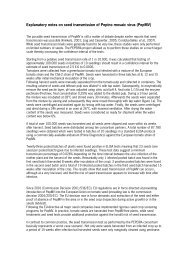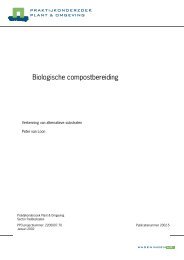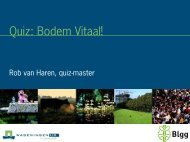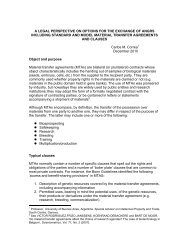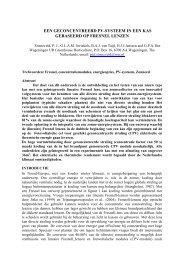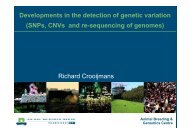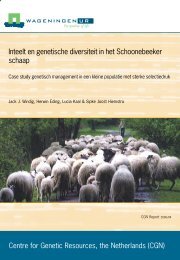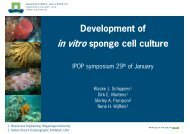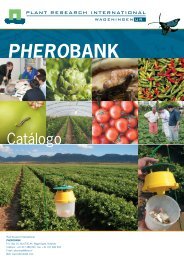ROLE OF BIVALVES IN CYCLING AND ... - Wageningen UR
ROLE OF BIVALVES IN CYCLING AND ... - Wageningen UR
ROLE OF BIVALVES IN CYCLING AND ... - Wageningen UR
Create successful ePaper yourself
Turn your PDF publications into a flip-book with our unique Google optimized e-Paper software.
<strong>ROLE</strong> <strong>OF</strong> <strong>BIVALVES</strong> <strong>IN</strong> CYCL<strong>IN</strong>G <strong>AND</strong> STORAGE <strong>OF</strong> NUTRIENTS:<br />
FEEDBACKS FROM FILTER FEEDERS<br />
Summary report of the WIAS minisymposium, June 4, 2012<br />
FOR THE POWER PO<strong>IN</strong>T PRESENTATIONS GO TO :<br />
www.imares.wur.nl/NL/onderzoek/aquacultuur/Produs/<br />
1
Mini symposium on June 4 th , 2012 in <strong>Wageningen</strong>, Zodiac, de Elst 1, 6708 WD <strong>Wageningen</strong>,<br />
building 122, room C 85:<br />
<strong>ROLE</strong> <strong>OF</strong> <strong>BIVALVES</strong> <strong>IN</strong> CYCL<strong>IN</strong>G <strong>AND</strong> STORAGE <strong>OF</strong> NUTRIENTS:<br />
FEEDBACKS FROM FILTER FEEDERS<br />
This symposium is organized by WIAS, the Aquaculture and Fisheries group (AFI) and the Institute of<br />
Marine Resources and Ecosystem Studies (IMARES) of <strong>Wageningen</strong> <strong>UR</strong>, at the occasion of the PhD<br />
defense of Henrice Jansen.<br />
Program:<br />
9.30 Welcome with coffee<br />
9.40 Opening by symposium chair Dr Marc Verdegem, AFI-W<strong>UR</strong><br />
9.45 Introduction – prof dr Aad Smaal – AFI-W<strong>UR</strong>, Imares, NL<br />
10.00 Nutrient regeneration by filter feeders – Ir Henrice Jansen – Imares, Yerseke, NL<br />
10.20 Shellfish farming in low nutrient environments – Dr Ovind Strand – IMR, Bergen, Norway<br />
10.40 Feedbacks of shellfish on nutrients and primary production - Dr Theo Prins, Deltares, NL<br />
11.00 Coffee break<br />
11.20 Filtration and biodeposition impacts of mussel seed on ecological carrying capacity - drs<br />
Wouter van Broekhoven & ir Pascalle Jacobs, W<strong>UR</strong> and Imares Yerseke / Texel, NL<br />
11.40 Nutrient extraction through mussel farming – Dr Jens Petersen, Shellfish Center,<br />
Nykobing, Denmark<br />
12.00 Extractive mussel aquaculture: balancing ecological good, services and impacts – Dr<br />
Peter Cranford – Bedford Institute, Halifax, Canada<br />
12.20 general discussion<br />
12.45 closure<br />
16.00 PhD defense of Henrice Jansen<br />
2
<strong>IN</strong>TRODUCTION<br />
Aad Smaal – AFI / Imares, W<strong>UR</strong>, NL; aad.smaal@wur.nl<br />
See power point<br />
CV<br />
Aad Smaal is senior scientist at the Delta Department of the Institute of Marine Resources and Ecosystem<br />
Studies (IMARES) in Yerseke, NL and he has a chair in sustainable shellfish culture at <strong>Wageningen</strong><br />
University. He started his carrier at the public works department, studying the impacts of the coastal<br />
engineering Delta project on the ecology of the Oosterschelde and adjacent ecosystems. He has been<br />
working in the field of ecology and bivalve aquaculture for over 30 years and has published over 50 peer<br />
reviewed papers. He is member of the board of directors of the European Aquaculture Society<br />
NUTRIENT REGENERATION BY FILTER FEEDERS<br />
Henrice Jansen – Imares, Yerseke, NL, henrice.jansen@wur.nl<br />
See power point<br />
CV<br />
Henrice Jansen has finished a PhD project at IMR Norway, studying the nutrient turnover by suspended<br />
mussel communities in oligotrophic fjords, in the framework of the CANO project. Previously she worked<br />
at Imares Ijmuiden in the field of aquaculture and aquatic ecology. She is now staff member of the<br />
aquaculture department of Imares in Yerseke, NL working on IMTA and other projects.<br />
SHELLFISH FARM<strong>IN</strong>G <strong>IN</strong> LOW NUTRIENT ENVIRONMENT.<br />
Øivind Strand - IMR, Bergen, Norway, Ovind.strand@imr.no<br />
Shellfish farming is typically found in coastal areas supplied nutrients from freshwater runoff and<br />
upwelled deeper water supporting phytoplankton production. Still, a large fraction of the biogeographical<br />
distribution of bivalves is in habitats characterized by oligo- to mesotrophic conditions. The water column<br />
stratification in fjords derived from the freshwater input limits nutrient supply to the euphotic layers after<br />
the spring blooms, creating oligotrophic conditions and low phytoplankton concentrations. This affects<br />
shellfish farming in Norway and questions has been raised if the low nutrient environments is constraining<br />
further development of the industry. I will present research on feeding behavior, food requirements for<br />
growth, seston depletion, and enhancement through controlled upwelling of nutrient rich deep water, all of<br />
relevance for demonstrating how shellfish farming can be maximized in such low nutrient environments.<br />
CV<br />
Øivind Strand is a Principal scientist at Institute of Marine Research in Bergen, Norway. He is a marine<br />
biologist with research experience in bivalve ecology and aquaculture, with a focus on bivalveenvironment<br />
interactions, scallop sea ranching and enhancement of carrying capacity of mussels by<br />
controlled up-welling in fjords. He is also the leader of the CANO (-bivalve) project.<br />
FEEDBACKS <strong>OF</strong> SHELLFISH ON NUTRIENTS <strong>AND</strong> PHYTOPLANKTON<br />
Theo Prins, Deltares, PO Box 177, 2600 MH Delft, The Netherlands theo.prins@deltares.nl<br />
3
In many estuarine and coastal ecosystems, bivalve suspension feeders exert a strong grazing<br />
pressure on the phytoplankton, resulting in a top-down control on phytoplankton and increased<br />
nutrient cycling, a flux of nutrients from phytoplankton biomass to the sediment and the dissolved<br />
inorganic nutrient pool, and shifts in phytoplankton composition.<br />
The Oosterschelde (SW Netherlands) is an example of a coastal embayment with high stocks of<br />
bivalve suspension feeders. Since 1990, external nutrient loading (N, P) to the Oosterschelde have<br />
decreased significantly due to measures to reduce coastal eutrophication. As a consequence, the<br />
relative importance of internal nutrient cycling in the Oosterschelde to sustain primary production<br />
and phytoplankton biomass has increased. Monitoring data of nutrients, phytoplankton species<br />
composition and biomass in the period 1990-2010 in the Oosterschelde were analyzed.<br />
Developments in nutrients and phytoplankton were compared to trends observed in the coastal<br />
waters of the North Sea, where the role of bivalve suspension feeders isless dominant. The effects<br />
of bivalve suspension feeders on nutrient cycling and on phytoplankton in the Oosterschelde will<br />
be discussed.<br />
CV<br />
Theo Prins is a marine ecologist who has been involved in basic and applied ecological research<br />
and in management and policy advice for more than 25 years. He has a broad background in<br />
estuarine and marine ecology, in field and experimental studies as well as in desk studies,<br />
covering the ecological impacts of infrastructural works, eutrophication and other human<br />
activities in estuarine and marine systems. He finished his PhD on the role of bivalves in estuarine<br />
nutrient cycling in 1996.<br />
FILTRATION <strong>AND</strong> BIODEPOSITION IMPACTS <strong>OF</strong> MUSSEL SEED ON ECOLOGICAL<br />
CARRY<strong>IN</strong>G CAPACITY<br />
Wouter van Broekhoven & Pascalle Jacobs, AFI/Imares, W<strong>UR</strong>, NL, wouter.vanbroekhoven@wur.nl<br />
Impact of seed mussel collectors on carrying capacity through nutrient regeneration<br />
Bivalves can be key mediators of nutrient circulation in aquatic ecosystems. Effects of bivalve aquaculture<br />
on carrying capacity, defined here as the level at which an ecosystem is able to support a particular (group<br />
of) species, may therefore be substantial. Bivalves may impair as well as stimulate carrying capacity as a<br />
result of their control of nutrient circulation by affecting nutrient circulation and thereby primary<br />
production. Primary production rates may be impaired by nutrient losses through harvest, denitrification<br />
and burial. Conversely, stimulation may occur as nutrients are recycled to primary producers through direct<br />
excretion or regeneration from waste products. Furthermore, nutrient stoichiometry may be changed if<br />
nutrients are absorbed and released on unequal timescales or in unequal proportions. In this study we<br />
estimate nutrient regeneration rates of seed mussels grown on Seed Mussel Collector (SMC) systems in the<br />
Netherlands. Deployed at an increasingly large scale, SMCs provide substrate for Mytilus edulis spat<br />
collection in macrotidal Dutch coastal systems. The summer period during which nutrient concentrations<br />
are lowest partly coincides with the period of highest SMC biomass. To be able to estimate effects on<br />
ecosystem functioning, we model mussel growth on SMCs using Dynamic Energy Budget modelling.<br />
Uptake and excretion rates from intact SMC sections are measured under field conditions using a<br />
mesoscale experiment. Furthermore, we define nutrient release from decomposing biodeposits because<br />
little is known about the fate of solid mussel waste in macrotidal systems.<br />
CV<br />
4
Wouter van Broekhoven is a marine ecologist (University of Groningen, Netherlands) with an interest in<br />
anthropogenic controlling factors of ecological processes. After graduating he worked in shellfish ecology<br />
during an exchange year at the National Institute of Environmental Studies of Japan. Then after two years<br />
working in water and nature policy for the Dutch ministry of Water, he obtained a second MSc in<br />
Conservation Science from Imperial College London. He is currently working on a PhD thesis at IMARES<br />
investigating nutrient feedback processes of mussel seed.<br />
Pascalle Jacobs<br />
Impact of seed mussel collectors on plankton communities in tidal ecosystems<br />
Bivalve grazing can have large effects on the carrying capacity of an area, due to both grazing and<br />
excretion of waste products. Grazing is expected to negatively impact the food availability for both SMC<br />
themselves as other filter feeders. Not only do bivalve cultures remove large amounts of phytoplankton,<br />
due to low clearance rates of the smallest algae, a change in phytoplankton composition is expected. A<br />
positive effect of mussel grazing might be the increased light penetration in the water, due to the removal<br />
of both debris and phytoplankton. At times when the growth of the phytoplankton community is light<br />
limited, grazing by mussels might increase the primary production. Another, less studied aspect of mussel<br />
grazing, is the removal of micro zooplankton like ciliates and the potential effect of changes in the micro<br />
zooplankton food web. In this study we focus on the effect of grazing by SMC seed mussels on the<br />
plankton community. By means of incubation experiments using natural phytoplankton community in<br />
mesocosms, clearance rates of both pico- and nanoplankton as well as micro zooplankton will be<br />
established. After the incubation experiments, development of the phytoplankton community will be<br />
monitored to investigate the recovery of the plankton community.<br />
CV<br />
Pascalle Jacobs started her PhD titled “Impact of seed mussel collectors on plankton communities in tidal<br />
ecosystems” in 2010 under supervision of Roel Riegman. Previously she obtained a M.Sc. degree in<br />
marine ecology and a M.Sc. in forest ecology. She worked as research assistant for the Universities of<br />
<strong>Wageningen</strong> and Edinburgh, as junior policy employee at the Netherlands Organisation for Scientific<br />
Research and as assistant press officer at <strong>Wageningen</strong> University and Research centre<br />
NUTRIENT EXCTRACTION THROUGH MUSSEL FARM<strong>IN</strong>G<br />
Jens Kjerulf Petersen, Danish Shellfish Centre, jkp@skaldyrcenter.dk<br />
With the Water Framework Directive, goals have been set for water quality in coastal waters. In Denmark<br />
have these goals been translated into reduction in loading of coastal waters with nutrients and in particular<br />
with nitrogen (N). Much focus has been given to various means of reduction on land, e.g. by changing<br />
agricultural practices, by establishing of wetlands in sensitive areas or by reducing animal husbandry or<br />
use of artificial fertilizers.<br />
An alternative or supplementary means of mitigation is by removing nutrients in the recipient. Mussel<br />
farming has been suggested as a way of mitigating effects of eutrophication: a) harvesting the mussels will<br />
remove nutrients; b) mussels will through their feeding mode improve water clarity and hence contribute to<br />
the achievement of environmental goals; and c) mussels can also mitigate effects of internal sources in<br />
coastal habitats. However, mitigation cultures have not yet been established in full scale and much of the<br />
expected impact has been restricted to theoretical considerations.<br />
A current Danish research project – Mussels, mitigation and feed for husbandry (MuMiHus) – has as aim<br />
to study the potential of using mussels as a means of mitigating excess nutrient loading. The project has<br />
5
had a Danish standard size mussel farm (approx. 18 ha) producing at full scale as experimental platform.<br />
The project has focussed on as well practical issues optimizing production volume as well as<br />
environmental impact, ecosystem effects and management models. In this presentation, principal<br />
considerations and first results of the MuMiHus are presented.<br />
Jens Kjerulf Petersen is M.Sc. in marine biology from University of Copenhagen, Ph.D. from University<br />
of Southern Denmark and is currently managing director at the Danish Shellfish Centre, an independent,<br />
private research unit located in Nykobing Mors. JKP has specialised in estuarine ecology with special<br />
focus on bentho-pelagic coupling, suspension feeder biology and ecology and shellfish production.<br />
EXTRACTIVE MUSSEL AQUACULT<strong>UR</strong>E: BALANC<strong>IN</strong>G ECOLOGICAL GOODS,<br />
SERVICES <strong>AND</strong> IMPACTS.<br />
Peter Cranford, Bedford Institute of Oceanography, Peter.Cranford@dfo-mpo.gc.ca<br />
The ecological engineering concept of introducing bivalve aquaculture as a means of extracting<br />
excess nutrients from coastal environments is derived from long-standing concepts on the<br />
ecological benefits provided by natural bivalve populations. The capacity to provide these<br />
services at both a commercial and environmental profit has added additional fuel to the rapid<br />
development of the bivalve aquaculture industry. Case studies on the use of extensive/intensive<br />
suspended mussel culture operations as biofilters to extract excess nutrients in coastal waters from<br />
land-use (i.e. eutrophication bioremediation) and from fish culture (Integrated Multi-Trophic<br />
Aquaculture) will be presented. The high complexity of aquaculture environment interactions will<br />
be highlighted to illustrate the need to balance the beneficial aspects of nutrient extraction against<br />
any concurrent ecological changes that could destabilize trophic pathways and nutrient dynamics.<br />
The intensity of impacts from bivalve culture operations are always site-specific, owing largely to<br />
local hydrodynamic conditions, and the goods and services provided will also vary with location.<br />
The capacity to balance the goods, services and impacts associated with these ecological<br />
engineering schemes is a fine art that will require an ecosystem-based approach and additional<br />
research effort.<br />
CV Peter Cranford is an oceanographer working for the Canadian government at the Bedford<br />
Institute of Oceanography and is an Adjunct Professor with the Department of Oceanography at<br />
Dalhousie University. His research specialties include bivalve physiological ecology and<br />
aquaculture environment interactions.<br />
General discussion with the speakers: O Strand, P. Cranford, T. Prins, J. Petersen & W. van Broekhoven<br />
6



